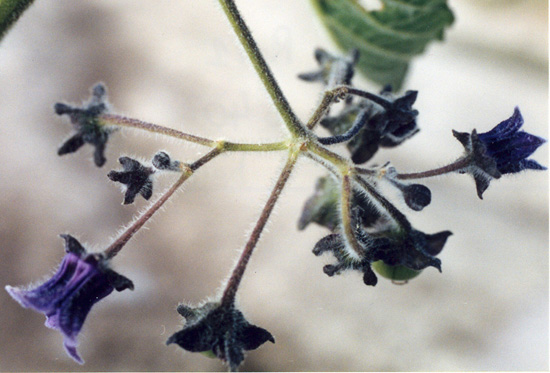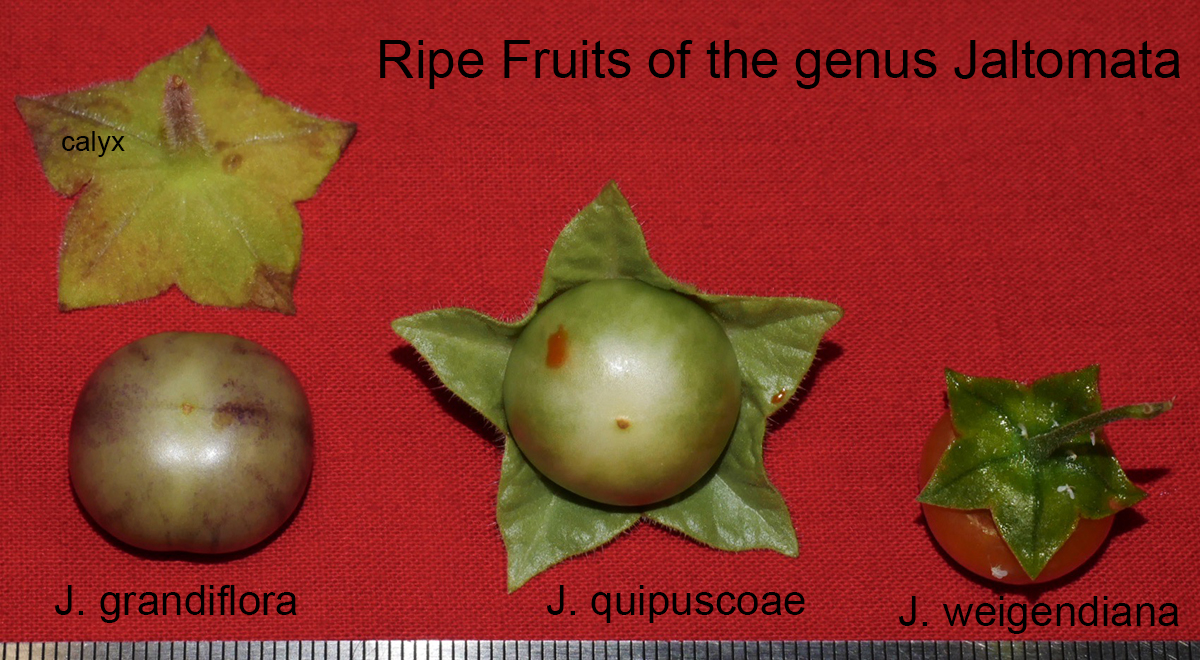| author | Schlechtendal | |
| bibliographic citation | Index Sem. (Halle) 8. 1838 | |
| vernacular names | follow this link | |
| derivation of genus name | Jaltomata may be a variant of Jaltomate, the name of a small pueblo in Zacatecas, Mexico (ca. 22 10' N, 101 47'W; Davis & Bye 1982, page 231). Gledhill (2008, page 220) lists Jaltomata as a "a Mexican vernacular name for False Holly." | |
| major synonyms | all Hebecladus (Andes), many Saracha | |
| growth form | Perennial. Most species are shrubs, some are herbaceous, usually to about 1 or 1.5 m high (when scandent, plants are up to 4 m long, and lack specialized structures). Some collectors of J. viridiflora have described it is a liana ("bejuco") on specimen labels (García Barriga 10402, COL; Uribe 5316, COL). |
|
| roots | tap root (expanded and therefore resembling a tuber in some collections of J. procumbens) |
photo of a tap root on the J. procumbens web page |
| pubescence / vestiture, trichomes | Overall, plants are glabrous to densely pubescent. The different kinds of hairs that one may encounter on surfaces of Jaltomata species are shown on another page, one can reach by following the link at right. |
follow this link to see trichomes of Jaltomata |
| branches | erect or spreading, 4- or 5-sided to terete, often hollow, to 4 cm diam but usually smaller. One species is consistently procumbent. | |
| Leaves | alternate or appearing opposite (rarely appearing verticillate), simple, petiolate, estipulate, ovate, ovate-lanceolate or ovate-acuminate, sometimes basally truncate, entire, subentire or toothed; sometimes tapering asymmetrically along distal portion of petiole. The leaves of at least one species are deciduous! | |
| Inflorescence | umbel-like (Figure 1) or branched in a few species (Figure 2), axillary or from a stem dichotomy (false dichotomy), flowers per inflorescence 1 - 41 (the high value of this range was recorded on a J. darycana plant cultivated for research and included both flowers and very small flower buds) pedunculate (exceptions follow: J. andersonii has an unarticulated axis joining the flower and the plant, by definition a peduncle though the peduncle may have been lost by reduction, and J. diversa lacks a peduncle -- the umbel-like inflorescence is sessile). pedicel basally articulated after fruit ripens pedicels and peduncles often angled in cross section |
Figures 1 & 2 |
| Flowers | 5-merous, actinomorphic/regular, bisexual/perfect, usually protogynous | |
| Calyx | enclosing the bud with valvate aestivation after flower fully opens: planar or lobes reflexed or bowl-shaped; sepals partially fused, stellate in outline, the lobes triangular, narrowly triangular or obtuse with fruit: conspicuously accrescent; green or purple; bowl-shaped around berry or planar or reflexed |
Figures 1 & 2 |
| Corolla color | Pale-green, whitish, white, blueish, blue-purple, purple, violet, some species red in base due to nectar and/or pigmentation in the base of corolla. |
|
purple corolla ring |
Some species of section Hebecladus,
but no species of sections Jaltomata and Modillonia, have this. J. mionei to the right shows the purple corolla ring. |
|
| Corolla | Actinomorphic; rotate, broadly infundibular, campanulate, tubular, urceolate and the limb revolute; 5-lobed, or lobes alternating with lobules totalling 10 lobes plus lobules; 1 - 6 cm in diameter aestivation with five valvate lobes, each lobe alternating with an inwardly pleated and shorter lobule |
|
Corona |
The corona is a bowl of tissue on which nectar pools. Only the three species of section Modillonia have a corona:J. aspera, J. calliantha, J. quipuscoae |
|
| Stamens | epipetalous at base of corolla, usually equal in length but there are exceptions | |
Radial thickenings from base of stamen toward corolla lobule |
Some South American species have radially oriented thickenings that extend from the base of each stamen toward the corolla lobule (or where the lobule would be if present), as shown in the photo of J. herrerae to the right). Where present, these create troughs (between radial thickenings) that hold nectar at the base of the corolla. Even the radial corolla thickenings of J. weberbaueri, so conspicuous in photos of fresh flowers, are extremely inconspicuous on herbarium specimens. One needs fresh flowers or flowers preseved in spirit to assess the presence/absence of this character (dry, pressed museum specimens alone will not allow one to accurately assess). |
|
| Filaments & Anthers | Filaments: filiform; markedly enlarged / swollen at base where adnate to base of corolla. The filament is inserted on the lower ventral face of the anther (nearly medifixed) in most species but is basifixed in the three species of section Modillonia. The anthers: ovate to linear, to 5 mm long, dehiscing longitudinally Stamens are connivent in distantly related species (J. procumbens race 321, J. paneroi). |
|
| Ovary | Superior, with an annular disk(1) around the base of the ovary, bicarpellate (rarely tricarpellate in J. auriculata, and J. repandidentata I grew) | |
| Ovules per ovary | 42 to about 700 | |
| Style | Straight (exceptions: the style of both J. darcyana and J. repandidentata are curved); exserted or not; slender (the styles of the three species that have a corona are thickest at the base and gradually decrease in diameter proximal to distal) |
|
| Stigma | Single, shallowly bilobed or bilobed; capitate (punctiform on the three species of section Modillonia); self-compatible in the species studied to date |
|
| Fruits | juicy globose or oblate berry; 4 - 25 mm in diameter; many-seeded; dropping at maturity (J. grandiflora, J. calliantha, J. quipuscoae) or remaining attached to parent plant and not dropping at maturity (J. procumbens, J. weigendiana)(figure 3); the berries of at least one species split open at maturity (J. chotanae); black/purple, green, orange, red or nearly white | |
| Seeds: | to 395, the quantity per fruit varies among species, ovate to reniform. Data from the field is not comprable with data from the greenhouse: for example, J. aijana collection Mione et al. 872 had 82 seeds in one fruit in the field (year 2016), and 38 to 40 seeds per full-size, ripe fruit (weeks after manual self-pollinations) in the greenhouse (year 2018). |
|
| Chromosome base number | 12 |
Davis 1975, Mione 1992 |
| Number of species worldwide | 70 |
|
| Nectar | Color & Relative Volume - clear (footnote 2) and produced in small volume, or in contrast red / orange and produced in much greater volume - filling the base of corolla and sometimes visible through the corolla.
|
Footnotes for the above: 1) The annular disk around the ovary (ovarian disk, the expanded base of the ovary) has been described as a nectary disk ("disco nectarífero" Benítez de Rojas 2010).
2) the nectar produced in J. darcyana, J. procumbens, J. repandidentata, and J. sinuosa isn't actually clear, but rather a very dilute pale yellow (J. Kostyun, personal communication, 2014).
Similar Genera
Jaltomata differs from Physalis by the former having a fruiting calyx that does not enclose the berry, while the fruiting calyx of Physalis encloses the berry.
Jaltomata differs from Solanum by the former producing nectar and having longitudinal anther dehiscence, while Solanum has anthers with terminal pores and does not produce floral nectar.
Jaltomata differs from Cuatresia by the former having basal pedicel articulation while the latter lacks pedicel articulation (Hunziker).
Habitat:
I have collected Jaltomata species most commonly along roadsides where the native vegetation is still present to some extent. If the native vegetation has been entirely eliminated for agriculture I usually can't find Jaltomata. In other words, most species are tolerant of a considerable amount of open sun, but not completely open sun. However, J. nigricolor and J. salpoensis are found in completely open sun, with no shade whatsoever. In the Andes, rock walls (J. sanchez-vegae) and steep roadside embankments are common habitats of Jaltomata species. The easiest way to find J. repandidentata is in coffee plantations that have not been weeded (Mexico to Bolivia), the coffee plants providing considerable shade. Even in the forest, when I have found Jaltomata it was along a trail or gravel road (Costa Rica) where light was entering through the canopy at least part of the day. In Mexico, the easiest way to find J. procumbens is in corn fields that have not been weeded, the corn plants usually providing shade depending on the height of the corn. Some Jaltomata species do not stand alone, and require other plants to grown among (J. dendroidea and J. pallascana, for example); here the physical support of other plants and the shade of other plants are inseparable. One species grows, with few exceptions, in between or very near the spiny leaves of Puya.
Most Jaltomata species are somewhere in the middle of the spectrum of dry to moist habitats. On the wet end of the spectrum there are ecotypes of J. procumbens that reside in the rainforest, for example in Costa Rica at high elevation, including an epiphyte at Monteverde. As well, J. werffii grows on wet slopes (Galápagos Islands). On the dry end of the spectrum are the species that reside in the lomas. And J. calliantha (red/orange nectar and green fruits) dies back to the ground for several months of the year; its habitat is seasonally quite dry. One of the lomas species has deciduous leaves, and it may receive no rainfall for months, and then when the fog returns, approximately in August, the leaves emerge again.
Geographic Distribution:
The approximately 60 species of Jaltomata are distributed from southeastern Arizona, USA (Kearney and Peebles, 1951) to southern Bolivia (Morton, 1944), on three of the Galápagos Islands (D'Arcy, 1982), and on the Greater Antilles (Cuba, Jamaica, Haiti, Dominican Republic, Puerto Rico; Adams, 1972; Davis and Bye, 1982; Liogier and Martorell, 1982). The majority of the species are Andean but one of the most common species, J. repandidentata, extends throughout much of the continental range of the genus, from Mexico to Bolivia (Mione and Yacher, 2005). The USDA Plants Profile (web site) for Jaltomata procumbens shows this species in Maryland, U.S.A. I have not seen collection(s) made from plants growing in Maryland. Highest Collection: J. yungayensis at 4,150 m of elevation (J. Mostacero L, S. Leiva G. et al. 1897).
In the department of Cajamarca, Peru, there are over 20 distinct and defendable species!
In the department of La Libertad, Peru there are so many species!
Link to Jaltomata of Arizona, Mexico and Central America
In Connecticut, USA, where I have grown outdoor plants of J. procumbens, seeds in fruits dropped to the ground in the fall have germinated during the following spring, becoming weeds in the garden where they were grown the year before. This suggests that the northern end of the range of this genus is limited by dispersal and / or successful establishement among competitors, not by sensitivity to cold.

